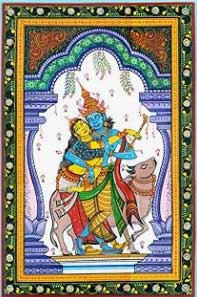Pattachitra painting is a traditional art form from Odisha, India. It is known for its intricate designs and mythological themes. The name “Pattachitra” comes from the Sanskrit words “patta” (canvas) and “chitra” (picture).

Image Source: Amazon | Buy Pattachitra painting from Amazon | WA 9990004135 for Class
Origin and History
Pattachitra painting originated in Odisha over a thousand years ago. It is closely linked to the Jagannath Temple in Puri. This art was created to depict stories from Hindu mythology.
The Process
Creating a Pattachitra traditional painting involves several steps:
- Preparing the Canvas: Artists use cloth, which is coated with a mixture of chalk and gum. This makes it smooth and suitable for painting.
- Drawing the Outline: They use a fine brush to draw intricate designs.
- Coloring: Natural colors made from minerals and plants are used.
- Detailing and Finishing: Artists add fine details and a lacquer coating to protect the painting.
Themes and Motifs
Pattachitra traditional paintings depict various themes:
- Hindu Gods and Goddesses: Common depictions include Krishna, Jagannath, and Durga.
- Mythological Stories: Scenes from epics like Ramayana and Mahabharata.
- Temple Rituals: Activities related to temple ceremonies and festivals.
Unique Characteristics
Pattachitra art paintings have special features:
- Intricate Designs: The paintings are detailed with fine lines and patterns.
- Bright Colors: Artists use vibrant, natural colors.
- Traditional Style: The style has remained unchanged for centuries, preserving its traditional charm.
Modern Relevance
Today, Pattachitra art paintings are appreciated worldwide. They are used in home decor and are popular among art collectors. Efforts are being made to preserve and promote this ancient art form.
FAQs
Q1. What is Pattachitra painting?
Pattachitra painting is a traditional Indian art form from Odisha, known for its intricate designs and mythological themes.
Q2. Where did Pattachitra art originate?
Pattachitra art originated in Odisha, India, over a thousand years ago.
Q3. What materials are used in Pattachitra art?
Artists use cloth for the canvas and natural colors made from minerals and plants.
Q4. How is a Pattachitra art made?
Artists prepare the canvas, draw intricate designs, apply vibrant colors, and add fine details.
Q5. What themes are common in Pattachitra art?
Common themes include Hindu gods and goddesses, mythological stories, and temple rituals.
Q6. What makes Pattachitra paintings unique?
Pattachitra paintings are unique for their intricate designs, bright colors, and traditional style.
Q7. Can Pattachitra paintings be used for home decor?
Yes, This paintings can be framed and used as decorative art in homes.
Q8. Where can I buy authentic Pattachitra traditional paintings?
You can buy authentic paintings from art galleries, craft fairs, and online stores.
Q9. How is Pattachitra art being preserved today?
Pattachitra art is preserved through workshops, exhibitions, and by supporting traditional artists.
Q10. Are there modern adaptations of Pattachitra art?
Yes, modern artists create new works inspired by Pattachitra art, blending traditional and contemporary styles.
Conclusion
Pattachitra painting is a beautiful and intricate art form from Odisha. Its detailed designs and bright colors make it unique and captivating. Supporting Pattachitra art helps preserve this ancient tradition for future generations.
View India’s popular art form
- Madhubani Painting: Also called Mithila Painting. Vibrant folk art from Bihar, known for intricate patterns and storytelling.
- Warli Art: Tribal art form from Maharashtra, characterized by simplistic yet expressive depictions of daily life.
- Tanjore Painting: Classical South Indian art form renowned for its rich use of gold foil and vibrant colors.
- Kalamkari Painting: Ancient art form from Andhra Pradesh, using natural dyes and intricate storytelling on cloth.
- Mughal Painting: Detailed miniature paintings from the Mughal era, showcasing courtly scenes and historical events.
- Gond Painting: Tribal art form from Madhya Pradesh, celebrated for its vibrant colors and intricate patterns inspired by nature.
- Rajasthani Miniature Painting: Diverse styles of miniature paintings from Rajasthan, depicting courtly life, landscapes, and religious themes.
- Kerala Mural Painting: Elaborate and colorful murals found in Kerala’s temples and palaces, showcasing Hindu mythology and folklore.
- Thangka Painting: Tibetan Buddhist art form practiced in parts of India, revered for its spiritual significance and intricate details.
- Kangra Painting: Miniature painting style from Himachal Pradesh, known for its romantic themes and delicate brushwork.
- Pichwai Painting: Devotional art form from Rajasthan, depicting Lord Krishna and his various leelas.
- Kalighat Painting: Folk art from Bengal, characterized by simple lines, bold colors, and depictions of everyday life and deities.
- Mysore Painting: Traditional art form from Karnataka, known for its delicate brushwork and intricate details.
